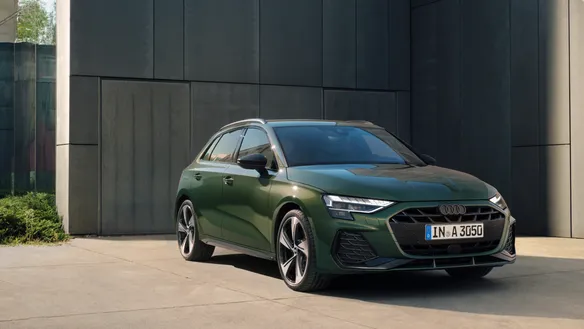Unique: the lighting technology of the Audi Q6 e-tron

The Audi brand aims to make “Progress through technology” accessible to its customers in fascinating vehicles. This also applies to lighting technology. Audi has been consistently and progressively leading the way in this field for years, driving forward the digitisation of light –and is currently demonstrating this lead once again with a world first in the new Audi Q6 e-tron.
Light comes alive
The active digital light signature combines the signature and movement of light for the first time. The aim of the Audi designers is to visualise agility and personal interaction with the Audi Q6 e-tron through constant movement of light. At first glance, the headlights and rear lights appear communicative and intelligent. The active digital light signature is protected and patented by Audi and, as a unique lighting design in the Audi Q6 e-tron, makes “Progress through lighting technology” visible in series production.
Technologically, this is a masterstroke by the Audi lighting development engineers. A software module of the new E³ 1.2 electronics architecture generates a new image of the active digital light signature every ten milliseconds using a specially developed algorithm. In the second generation of digital OLED rear lights, which the Audi Q6 e-tron has for the first time in series production, 360 segments in six digital OLED panels can be controlled for a customised lighting design. This technological advance enabled the developers to create a dynamic lighting design such as the active digital light signature. The active digital light signature with twelve segments that dim up and down is created in the digital daytime running lights of the matrix LED headlights at the front.
And that is the crucial point: dimming up and down. Dr Werner Thomas, project manager for digital OLED and exterior displays, is responsible for the development of the technology: “Legislation prohibits any variation in brightness in a vehicle’s lighting function. During pre-development, however, we discovered that we could divide our OLED component into switchable segments. This means that we can make one segment brighter and dim a sub-segment darker at the same time, so that people can see movement. However, a control instance in the software ensures that the light intensity always remains constant.“
One of the keys to Audi’s success in bringing this innovation to series production is early coordination with the technical services of the vehicle homologation authority. Florian Runkel, responsible for implementing the exterior light function in series production: “We’ve spent years in very constructive discussions with the authorities, describing what we intend to do, showing prototypes, carrying out light image measurements, adapting algorithms, providing evidence. Always making sure that we comply with the legal boundary conditions, especially when it comes to the constant light intensity.”
The active digital light signature combines the signature and movement of light for the first time.
Symbols in the rear lights
Intensive coordination with the authorities took place not only on the active digital light signature, but also on the second innovation in lighting technology in the Audi Q6 e-tron, the communication lights, extending the proximity detection already familiar from other Audi models.
The communication lights can contribute to increasing road safety by warning other road users of accident and breakdown sites, which they obtain from swarm data. To this end, the communication lights in the second-generation digital OLED combination rear light display a specific static taillight signature with an integrated triangle warning symbol in addition to the regular taillight graphic. The communication light warning will we displayed when the hazard warning lights, an emergency call, a breakdown call, the emergency brake lights, Emergency Assist or the exit warning function are activated. In addition, the communication lights use a specific light signature at the front and rear to indicate the status of the vehicle’s parking assistant when it is in an automated parking manoeuvre¹.
Audi is the only car manufacturer to have recognised the potential of OLED lighting technology and has consistently developed and digitised it. Leon Werner Schmidt, functional project manager for communication lights and digital light signatures: “This technology as an Audi USP enables us to functionally expand the scope of the rear lights to include car-to-x communication and content, such as symbols in the rear lights.”
This could also point the way to the future of automated driving. Selina Hirsch, Communication Lighting Strategy: “When you think about autonomous¹ driving, you want to communicate via the outer skin of the vehicle using light. The rear is the ideal place for this, as it can be seen by all vehicles travelling behind. We are increasing our use of OLED technology to create a display because we want to communicate with our surroundings.”
The communication lights can contribute to increasing road safety by warning other road users of accident and breakdown sites.

¹Please note: The systems work only within system limits and provide assistance while driving. However, the driver remains responsible for driving the vehicle and is required to be attentive at all times.
¹Please note: The systems work only within system limits and provide assistance while driving. However, the driver remains responsible for driving the vehicle and is required to be attentive at all times.






